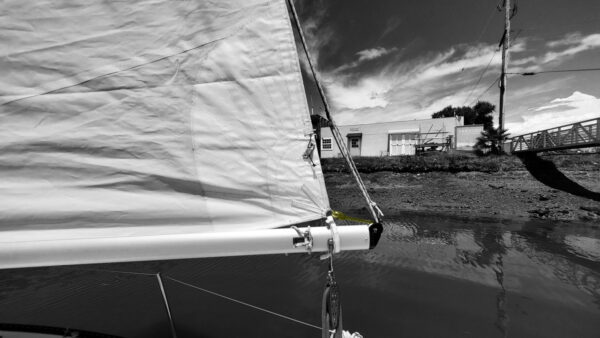How to Sail Comfortably in 20 Knots of Wind
It’s April, and for San Francisco Bay sailors that means one thing: Flame on! Starting about now, our famous winds start up — and keep going. Within a few weeks, we’ll be having our usual small craft advisories on the bay just about every afternoon.
If you sail here, it’s something you come to view as normal and generally no big deal.
Except… if you haven’t figured out yet how to downshift from full-sail, light-wind sailing. For you, this idea of sailing in wind that turns the bay into semi-froth might seem more than a little daunting.
If that’s the case, this is the article for you. It’ll show you how to get yourself and your boat set up to sail comfortably and happily even as the wind tries to blow your eyebrows off.
Step one: Recognize that it’s probably going to be windy. You can confirm that a number of ways. Here are four ways to do that.
1) The NOAA marine weather forecast for the South Bay is also found on our resource page.
2) You can also check your favorite weather app, but please be aware that, in my experience, those apps are essentially useless for predicting wind with any accuracy on San Francisco Bay. They’ll give you a number, but there’s very little chance it’ll be even close to correct.
The one exception to that rule is the paid version of an app and web site called SailFlow. SailFlow’s paid versions have wind forecasts that are frequently completely at odds with the (generally inaccurate) free forecasts provided by SailFlow. (Subscriptions cost about $4/month and up.)
3) Check the latest wind data from the weather station that NOAA maintains at the Port of Redwood City. The data are updated on the site every 6 minutes but, oddly, the most recent report is never less than 20 minutes old.
(The same data is also available through the free SailFlow version, along with data from a large number of other sites.)
4) Finally, when you arrive at the marina, look to the southwest. If you see fingers of fog poking over the coastal range, it’s either already windy on the bay or it’s probably going to get windy. No fog fingers, probably means it won’t get too windy on the water.
Step two: Plan to rig your boat for windy conditions. Primarily, that means get comfortable with reefing your mainsail and rolling up some or all of your jib. But there’s a lot more you can and should also do. Think of these as shifting to lower gears, as you would in your car if you’re heading up a steep hill.
Here are five ways to downshift to handle higher winds.
1) Tighten your outhaul. This will help flatten the mainsail and help to reduce excess heel.

Outhaul 
Outhaul
2) If the wind is reaching 10 knots (meaning you see whitecaps on the open bay) and you’re beginning to feel a little over-powered, ease your traveler down to leeward and tighten your mainsheet. If you’re close-hauled, the idea is to keep your boom in about the same position it would be if the traveler were centered.
The idea is to give the mainsail less leverage to heel your boat.

3) Tighten your backstay. This is particularly helpful on Merit 25s, which have a fractional rig. Tightening the backstay on a fractional rig boat helps to flatten the mainsail while also stabilizing the luff of the jib.

4) As the wind gets stronger, you’re going to induce some twist in your mainsail, which means you’re going to luff the top of your mainsail — which has the most leverage to heel your boat — while the lower portion of your main continues to draw normally. Doing this requires adjusting four items: Traveler, sheet, vang and potentially mainsail topping lift.
First, ease your vang to let your boom rise. Second, move your traveler to windward while easing your mainsheet. Once again, the idea is that your boom’s angle to the wind shouldn’t change. These three steps will have the effect of loosening tension on your mainsail leach, allowing the top part of the leach to pay out slightly to leeward. You can ensure that effect by tightening the main boom topping lift.
I think of the topping lift and the vang as two parts of the same tool whose job is to set the boom’s vertical position.

Boomvang 
Topping Lift
5) As the windspeed moves above 15 knots, it’s time to reef the mainsail, which you can do while heaved to. Or, if you think it’s going to get windy while you’re out, you can reef as part of the process of raising your mainsail.
Each of the previous four steps — using your traveler, backstay, vang, topping lift and mainsheet to shape the mainsail — also function under a reefed mainsail. So as the wind nears 20 knots, you can combine some of these steps.
If you’ve reefed your mainsail, it’s probably also time to reef your jib. You can roll it partway or completely, depending on conditions. That will make the boat easier to steer — and your jib trimmers will have a dramatically easier task trimming the sail.
If the wind is strong, you may find the violently luffing jib difficult to roll in. Try turning the boat to a broad reach, being careful to avoid an accidental jibe. That will reduce your apparent wind, and your jib will be partly in the wind shadow of the mainsail, both of which will make it easier to roll in the jib.
Step three: Experiment with these tools. Try easing the traveler to leeward and see how your heel angle changes. Try easing the vang and see what happens to heel. Try tightening the backstay and observe heel angle.
Get comfortable with these controls and you’ll find you’re able to sail in the bay’s exuberant winds with confidence.



